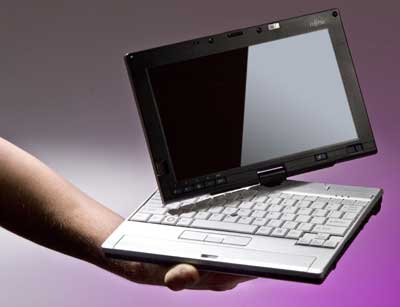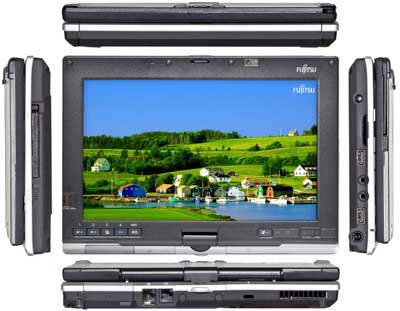|
Fujitsu LifeBook P1630
Small LifeBook pen-convertible gets another update
(by Kirk Linsky)
Fujitsu has a long history of offering tiny little pen-enabled notebook(let)s that are intriguing alternatives to larger, heavier laptops, especially for those who spend a lot of time on the road. The latest iteration, the LifeBook P1630, is an update to the P1620, which was a January 2008 update of the original LifeBook P1610. The P1630 is fashionably tiny with a footprint of just 9.15 x 6.6 inches. It's also just over an inch thick and weighs next to nothing (2.2 pounds).

Small size, however, doesn't mean inadequate specs. While the original P1610 was perhaps a bit underpowered with a Core Solo processor, the P1620 had a 1.2GHz Ultra Low Voltage Intel Core 2 Duo processor, and the new U1630 a 1.2GHz ultra low voltage Core 2 Duo SU9300 with 3MB of L2 cache and a speedy 800MHz frontside bus. It uses the Intel GS45 and Graphics Media Accelerator 4500HD. Base RAM is a full gigabyte of DDR2 667 SDRAM, but you're better off using the sole Micro-DIMM slot for a 2GB chip if you plan on using the Vista Business Edition instead of taking advantage of rhe XP Pro or XP Tablet PC 2005 Edition "downgrade service." The hard disk range has been updated again and you can get a shockmounted 80 or 120GB disk spinning at a faster 5400rpm and using the quicker SATA interface as opposed to the 1620's slower PATA disks, or you cn go for an even better (but at US$510 upgrade cost) expensive 64GB Solid State Disk. On the wireless side, you have a choice between Atheros XSPAN or the Intel Wireless WiFi Link 5300AGN modules, both new. Security is addressed via a Trusted Platform Module, a built-in biometric Fingerprint Sensor, and accompanying software.

Note that, as before, the P1630 can be converted into a tablet slate but only has a passive digitizer and not a Wacom-style active one with cursor tracking. The display measures 8.9 inches diagonally and has a sharp 1280 x 800 pixel 16:10 aspect ratio LCD -- and that's a lot of pixels for such a small screen. Also, unlike almost all Tablet PCs that use the swivel display hinge, the 1620P's goes both ways. And while the standard 3-cell battery offers only acceptable battery life of about three hours, you can replace it with a 6-cell extended battery that packs twice the punch, but adds barely anything to size and weight.
We usually don't like scaled-down keyboards, but in this day and age of thumbtype keyboards, and also given the P1630's tiny size, the 16mm key pitch is acceptable.
Base price rose again from the original P1610's release price of US$1,599 to the P1620's release price of US1,749, to the new P1630's very steep US$2,179. That is an awful lot of money even if you consider that ultra-light computers generally cost more.
|
|
|
|
Specifications Fujitsu LifeBook P1620
|
|
Added/changed
|
Added 11/2008
|
|
Form-factor
|
Pen-enabled Notebook
|
|
OS
|
Windows Vista Business with downgrade service to Windows XP or Windows XP Tablet PC Edition 2005
|
|
Processor
|
Intel Core 2 Duo SU9300
|
CPU Speed
|
1.20 GHz, 3MB L2 cache, 800 MHz FSB
|
|
Chipset
|
Intel GS45 and Graphics Media Accelerator 4500HD
|
Standard/Max RAM
|
1-2GB DDR2 667MHz in one Micro-DIMM slot
|
Disk/drive
|
Shock-mounted 80 or 120GB 5400 rpm P-ATA 100, or 32GB Solid State Drive
|
Card slots
|
1 PC Card Type II, 1 SD Card
|
Display type
|
Transmissive TFT
|
Display size/res
|
8.9-inch/1280x800
|
Digitizer/pens
|
Passive digitizer/1
|
Keyboard/scale
|
82-key integrated, 16mm pitch
|
Ruggedness
|
Standard
|
Housing
|
Unknown
|
Size (WxHxD)
|
9.15 x 6.6 x 1.36
|
Weight
|
2.2 lbs. with 28 WHr battery, 2.5 lbs. with 56 Whr battery
|
Power
|
3-cell 28 WHr Li-Ion ("up to 3 hrs"); 6-cell 56 WHr ("up to 6.25 hrs")
|
Interface
|
2 USB 2.0, RJ11, RJ45, dock, 1.3mp camera, fingerprint sensor
|
Interface
|
Bluetooth v2.1 (opt.), audio, Atheros XSPAN (802.11a/b/g/n) or Intel WiFi Link 5300AGN, video
|
List price
|
from US$2,179
|
Website
|
Fujitsu
|
|
|
Search
|
|
|
|



